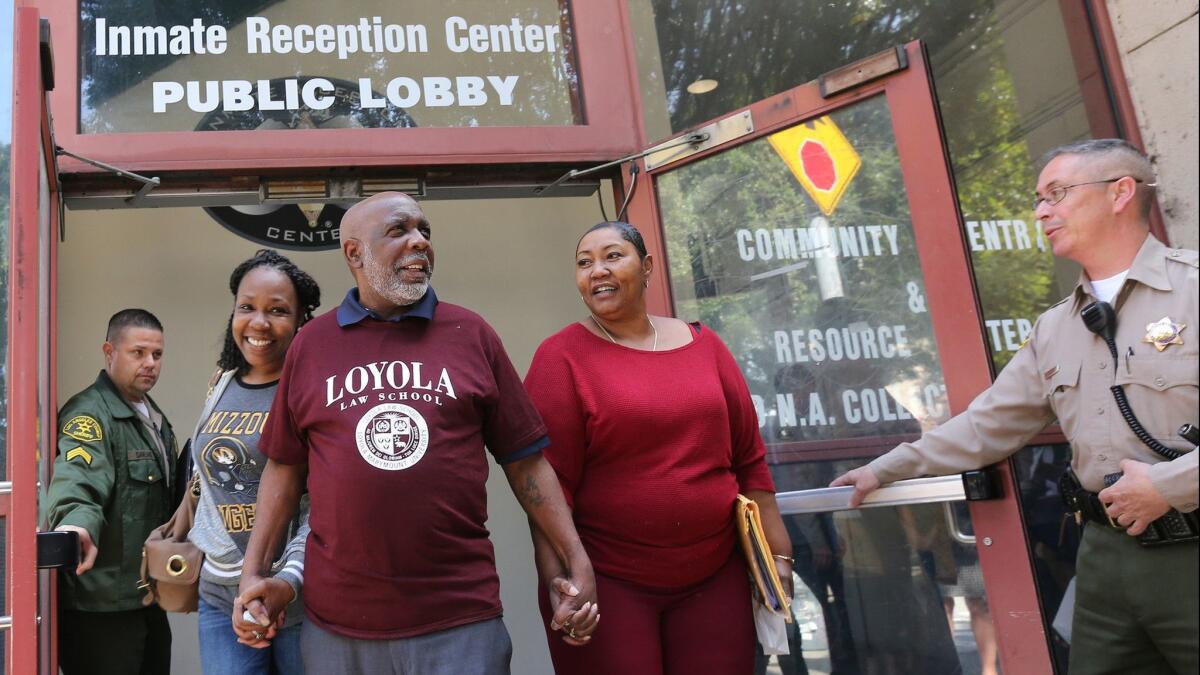âYou took 32 years of my lifeâ: Freed man accuses LAPD detective of manipulating eyewitness ID

The teenager stared at 16 mugshots, searching for the face of the man who had stabbed her boyfriend to death while they slept in his pickup truck in South L.A.
It was November 1984 â a month after the slaying â and Saladena Bishop already had pointed police toward two suspects who were quickly ruled out. Now, Los Angeles police Det. Richard Marks had a new photo lineup, and he drew her attention to No. 7.
âWhat about him?â the detective asked, referring to a picture of Andrew Wilson.
Bishop said that was the man â she was nearly certain, according to Marks.
Wilson, who always maintained his innocence, was convicted and sentenced to life in prison in a case that relied almost entirely on the witnessâ identification. More than three decades passed before a judge in 2017 threw out the conviction and freed him.
A civil rights lawsuit filed this week by Wilson, 63, accuses Marks of leading the witness to falsely identify him as a killer â and underscores a continuing controversy over the way many police agencies handle eyewitness identifications.
The age-old police method of asking someone to pick a suspect from a lineup has fallen under increasing scrutiny in recent years and shoulders some of the blame for hundreds of wrongful convictions across the country. The straightforward witness direction by Marks has drawn sharp criticism from prosecutors, defense attorneys and eyewitness memory experts.
Wilsonâs lawsuit against the former detective, as well as the city and county of Los Angeles, alleges that Marksâ actions were unconstitutional and that the district attorneyâs office for years failed to protect the rights of criminal suspects.
âYou took 32 years of my life,â Wilson said during a recent interview. âYou canât give that back to me.â
Last year, a record 37 people were exonerated in cases based, at least in part, on bad eyewitness identifications, according to a national database.
To address the problem, a California commission more than a decade ago urged police to stop having lead detectives show witnesses an array of photographs of possible suspects side by side. Instead, the panel recommended adopting a âdouble-blindâ procedure, in which an officer who doesnât know which picture belongs to the suspect shows the witness a series of photographs one after the other.
Advocates of the method say it prevents officers from even unconsciously steering a witness to a particular photograph. Several law enforcement agencies, including those in North Carolina and New Jersey, as well as the San Francisco Police Department and law enforcement in Santa Clara County, have switched to the method. But others, including the LAPD, have been reluctant to adopt the double-blind method and still allow case investigators to handle lineups.
Earlier this year, labor unions representing prosecutors and the LAPDâs rank-and-file opposed a bill that would require the practice.
The police union said it believes the proposed law would lead to fewer solved crimes, arguing that witnesses and victims âwill be unwilling to freely offer information to anyone they do not know, trust or feel comfortable with,â according to state documents.
The way Marks directed the witness to Wilsonâs photo â a practice he said he used at times throughout his career â is an overt example of how eyewitness identification can go wrong, said Gary L. Wells, an Iowa State University psychology professor who has studied the practice for decades.
âThe problems here are legion,â Wells said. âHeâs just completely giving out his hypothesis that thatâs the guy weâre focused on.â
Witnesses, he said, âtend to think that police know the answer, and theyâre there to help provide confirmation.â
In an interview with The Times, Marks defended his handling of Wilsonâs case, saying he made clear notes in the official record about having directed the witness. The retired detective said he has read literature on eyewitness identification in recent years and agrees it has limitations, but doesnât think his actions led to a false identification.
âI certainly have a clear conscience,â he said.
After his retirement in 2008, Marks did consulting work for the district attorneyâs office, reviewing evidence and offering his opinion in at least two high-profile police shootings â which ultimately ended in prosecutors declining to file charges against the officers in either case.
The district attorneyâs office declined to comment, citing the pending litigation; the LAPD did not respond to a request for comment.
From behind bars, Wilson in 1999 filed an official complaint about Marks with the LAPD, according to the lawsuit.
But the first sign of hope didnât come until August 2014, when he got a letter from a deputy federal public defender. The attorney wrote that he represented another man serving life for murder, and that an eyewitness had recently recanted, saying Marks and his partner had coerced a false identification. Marks denied any wrongdoing in that case.
Not long after, the attorney visited Wilson in prison and alerted Loyola Law Schoolâs innocence project, which championed the case.
Loyola lawyers tracked down the trial prosecutor, Laura Aalto, who in July 2016 signed a declaration saying sheâd long felt âuneasyâ about the prosecution. Aalto wrote that during Wilsonâs trial, she wasnât aware Marks had directed the witness during the photo lineup.
âI do not know,â she wrote, âhow any detective could have thought that was a legitimate way to conduct an identification procedure, even in 1984.â
Five months later, Marks sat down for a recorded interview with Wilsonâs lawyers and a deputy district attorney.
The detective said he considered Wilson a âthug,â clarifying he meant someone who committed crimes to support a drug habit. During the interview, the prosecutor asked Marks what he had meant years earlier, when he wrote in an affidavit that he had âdirectedâ the eyewitness to Wilsonâs photo.
âJust exactly what it says,â Marks responded, saying he asked her to look at a picture of Wilson and asked something along the lines of âWhat about him?â
Marks said he intentionally made a record of having directed the witness, as he figured it would be an issue requiring litigation before trial. In the affidavit attached to an arrest warrant, Marks wrote that he had included photographs of Wilson and another man, who was initially arrested as a co-defendant. While looking at the photos, Marks wrote, the witness âhesitatedâ over a photo of the other man, saying she would need to see a live lineup.
âShe then eliminated several other photos,â Marks wrote, adding that he then âdirected her attention to Wilsonâs photo, which she then identified with 80% confidence.â
During an interview this week, Marks stressed that a judge ultimately signed the arrest warrant and that his affidavit was in the case documents he gave the prosecutor.
âThis isnât something that was buried,â he said.
Wilsonâs lawsuit contends that the defense never got a copy of Marksâ affidavit, but the retired detective said he âcanât conceiveâ of that notion, saying he recalled one of Wilsonâs attorneys coming to the police station with a portable device to make copies of sections of the case evidence. (The attorney, Jim Barnes, doesnât specifically recall the case, but said neither he nor his office had portable copiers during the 1980s, according to the lawsuit.)
During the 2016 interview with the Loyola lawyers, Marks said that at a subsequent live lineup, Bishop recalled that she knew Wilsonâs face from before â she had babysat for his daughter, records show.
Was it possible, the prosecutor asked, that the witness identified Wilson because sheâd recognized him from earlier?
âIs it a possibility?â Marks said. âYeah.â
âWere you concerned about that?â the prosecutor asked.
âI wouldnât say that I was concerned,â Marks said.
When Wilson got out of prison, he felt joy but also crushing sadness and fear. He thought about the people heâd lost while incarcerated â a sister, his eldest grandson â and decided to move to St. Louis to be near his 98-year-old mother. He applied for jobs, but didnât hear back.
When he finally got work mopping floors at a chemical lab, he often showed up to his shift two hours early. He wanted his co-workers to see him â if anyone came asking, heâd have an alibi. But he recently slipped on the job and hurt his lower back, so he has missed a lot of work for doctorâs appointments, Wilson said.
His adult daughter, who lives in Michigan, calls 10 to 12 times a day to check in.
The hardest part, Wilson says, is the debilitating fear that authorities will target him again. He often wakes up in a panic in the middle of the night.
On a recent afternoon â when it was 85 degrees outside and he had a full tank of gas in his car â he told himself he really should be outside at the park with his girlfriend. Instead, he holed up inside. He doesnât run errands when itâs dark outside, and the sight of a patrol car sparks a panic attack â his heart races and his breathing gets short.
âThat fear will always be in me,â he says. âI donât want be on the other end of that again. I just canât. I donât have 32 more years to give.â
He thinks about Marks every day â and about the other people the detective investigated. During his long career with the LAPD, Marks was listed as a possible witness in at least 40 criminal cases, according to the district attorneyâs office.
âHe gets a pension,â Wilson said, âand the best I could get was a job mopping floors?â
For more news from the Los Angeles County courts, follow me on Twitter: @marisagerber
More to Read
Sign up for Essential California
The most important California stories and recommendations in your inbox every morning.
You may occasionally receive promotional content from the Los Angeles Times.











